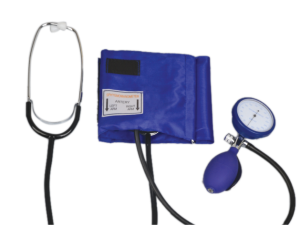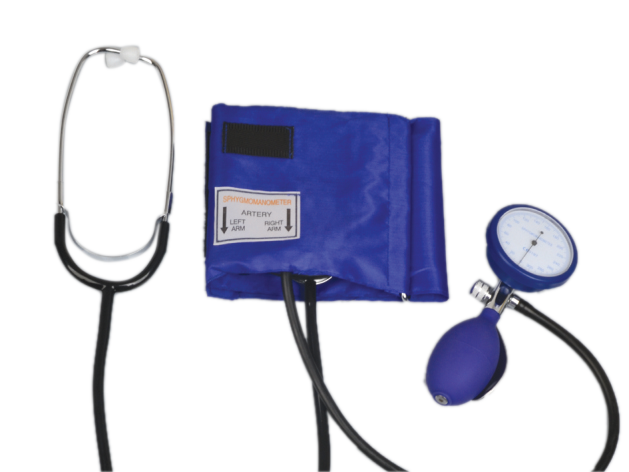Aneroid Sphygmomanometer (palm type, with attached single head stethoscope)
Aneroid (palm type) Sphygmomanometer, also known as a blood pressure examiner, or blood pressure hand, is a device used to measure blood pressure. It is composed of an inflatable cuff to collapse and release the roadway under the cuff in a controlled manner, and a mercury or aneroid manometer to measure the pressure. Aneroid Sphygmomanometer (palm type) are used with a stethoscope when using the auscultatory fashion.
Description
Blue nylon cuff with D-ring, blue rough PVC bulb, PVC inflation system, non-stop pin, single tubing.
What is an Aneroid Sphygmomanometer?
An aneroid sphygmomanometer is a type of stethoscope that uses an air pressure gauge to measure heart sounds. The single-head design makes it easier to hear faint heart sounds. Aneroid sphygmomanometers are most commonly used in pediatrics, but can also be found in other medical settings.
What are the benefits of using an aneroid sphygmomanometer?
One benefit of using an aneroid sphygmomanometer is that it is easier to hear faint heart sounds. Another benefit is that it is less likely to create noise than other types of stethoscopes.
How Does an Aneroid Sphygmomanometer Work?
An aneroid sphygmomanometer is a medical instrument used to measure blood pressure. It is a single-headed stethoscope with an aneroid spring attached to the chestpiece. The aneroid spring measures the pressure of the blood flowing through the arteries and veins, which is then used to calculate the person's blood pressure.
Advantages of an Aneroid Sphygmomanometer over Other Body Sounds Instruments
There are a few reasons why an aneroid sphygmomanometer is typically preferred over other body sound instruments, such as stethoscopes. First and foremost, an aneroid sphygmomanometer is more accurate in measuring blood pressure than a stethoscope. Additionally, an aneroid sphygmomanometer is less likely to cause painful clicks or pops when it's being used to measure heart rate.
Aneroid Sphygmomanometer (palm type) also known as a blood pressure examiner, or blood pressure hand, is a device used to measure blood pressure, composed of an inflatable cuff to collapse and also release the roadway under the cuff in a controlled manner, and a mercury or aneroid manometer to measure the pressure. Homemade sphygmomanometers are used with a stethoscope when using the auscultatory fashion.
Aneroid Sphygmomanometer (palm type)
Aneroid Sphygmomanometer (palm type) consists of an inflatable cuff, a measuring unit (the mercury manometer, or aneroid hand), and a medium for affectation which may be a manually operated bulb and stopcock or a pump operated electrically.
A stethoscope is needed for auscultation ( see below).Aneroid Sphygmomanometer (palm type) measures are used by trained interpreters, and, while it's possible to gain a introductory reading through palpation alone, this yields only the systolic pressure.
Mercury sphygmomanometers are considered the gold standard. They indicate pressure with a column of mercury, which doesn't bear recalibration. Because of their delicacy, they're frequently used in clinical trials of medicines and in clinical evaluations of high- threat cases, including pregnant women. A constantly used wall mounted mercury sphygmomanometer is also known as a Bauman meter.
Aneroid sphygmomanometers ( mechanical types with a dial) are in common use; they may bear estimation checks, unlike mercury manometers. Aneroid sphygmomanometers are considered safer than mercury sphygmomanometers,
Digital measures employ oscillometric measures and electronic computations rather than auscultation. They may use homemade or automatic affectation, but both types are electronic, easy to operate without training, and can be used in noisy surroundings. They measure systolic and diastolic pressures by oscillometric discovery, employing either deformable membranes that are measured using discriminational capacitance, or discriminational piezoresistance, and they include a microprocessor. They measure blood pressure and palpitation rate, while systolic and diastolic pressures are attained less directly than with homemade measures, and estimation is also a concern. Digital oscillometric observers may not be judicious for some cases, similar as those suffering from arteriosclerosis, arrhythmia, preeclampsia, pulsus alternans, and pulsus paradoxus, as their computations may not correct for these conditions, and in these cases, an analog sphygmomanometer is preferable when used by a trained person.
Digital instruments may use a cuff placed, in
order of delicacy and inverse order of portability and convenience, around the upper arm, the wrist, or a cutlet. Lately, a group of experimenters at Michigan State University developed a smartphone grounded device that uses oscillometry to estimate blood pressure. The oscillometric system of discovery used gives blood pressure readings that differ from those determined by auscultation, and vary according to numerous factors, similar as palpitation pressure, heart rate and arterial stiffness, although some instruments are claimed also to measure arterial stiffness, and some can descry irregular jiffs.

